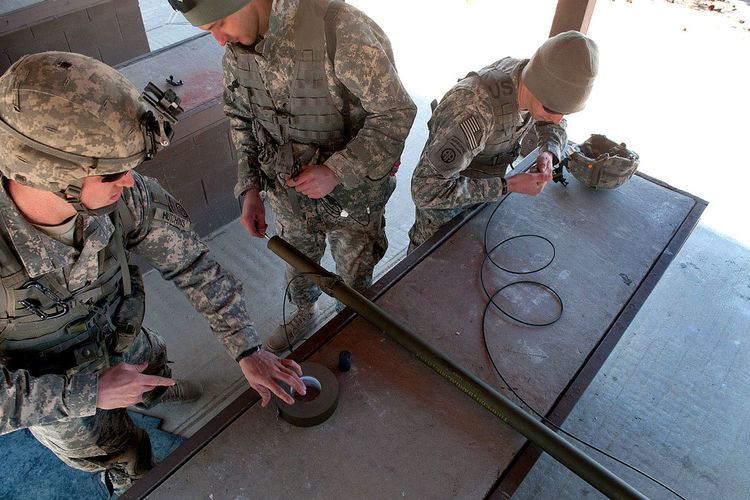Designer Captain McClintock | In service 1914-present Designed 1912 | |
 | ||
Used by Indian Army, Pakistani Army, British Army, Canadian Army, United States Army, Peoples Liberation Army (China), Finnish Defense Forces, Philippine Army, Philippine Constabulary, Philippine Marine Corps Wars | ||
A Bangalore torpedo is an explosive charge placed within one or several connected tubes. It is used by combat engineers to clear obstacles that would otherwise require them to approach directly, possibly under fire. It is sometimes colloquially referred to as a "Bangalore mine", "banger" or simply "Bangalore".
Contents
- Overview
- In World War I
- In World War II
- Post World War II development
- Other recent path clearing devices
- Depiction in film
- References
Per United States Army Field Manual 5-250 section 1-14, page 1-12 "b. Use. The primary use of the torpedo is clearing paths through wire obstacles and heavy undergrowth. It will clear a 3- to 4-metre wide path through wire obstacles."
Overview
The Bangalore torpedo was first devised by Captain McClintock, of the British Indian Army unit the Madras Sappers and Miners at Bangalore, India, in 1912. He invented it as a means of exploding booby traps and barricades left over from the Boer War and the Russo-Japanese War. The Bangalore torpedo could be exploded over a mine without a sapper having to approach closer than about 3 m (10 ft).
Bangalore torpedoes are currently manufactured by Mondial Defence Systems of Poole, UK, for the UK and US armed forces. They have been used recently in operations in Afghanistan for actions such as clearing enemy supply dumps within deep cave systems.
In World War I
By the time of World War I the Bangalore torpedo was primarily used for clearing barbed wire before an attack. It could be used while under fire, from a protected position in a trench. The torpedo was standardized to consist of a number of externally identical 1.5 m (5 ft) lengths of threaded pipe, one of which contained the explosive charge. The pipes would be screwed together using connecting sleeves to make a longer pipe of the required length, somewhat like a chimney brush or drain clearing rod.
A smooth nose cone would be screwed on the end to prevent snagging on the ground. It would then be pushed forward from a protected position and detonated, to clear a 1.5 m (5 ft) wide hole through barbed wire. During the 1917 Battle of Cambrai, British Royal Engineers used them as diversions to distract the enemy from where the real battle was to be fought.
In World War II
The Bangalore torpedo was later adopted by the U.S. Army during World War II, as the "M1A1 Bangalore torpedo". It was widely used by the U.S. Army, notably during the D-Day landings.
The Bangalore torpedo was reportedly used in the British offensive on Bardia during the Western Desert Campaign, on 3 January 1941.
The Bangalore torpedo was obsolete in British use at the time of D-Day having been replaced by rocket launched Congers and Armoured Vehicle Royal Engineers (AVRE) vehicles equipped with an 40-pound (18 kg) explosive charge for bunker clearing.
Post World War II development
The Bangalore continues to be used today in the little-changed M1A2 version, primarily to breach wire obstacles. British Royal Engineers, Canadian combat engineers and infantry assault pioneers, along with American combat engineers, have also been known to construct similar field versions of the Bangalore by assembling segments of metal picket posts and filling the concave portion with plastic explosive. The PE is then primed with detonating cord and a detonator, and pickets are taped or wired together to make a long torpedo, producing fragments (aka "shrapnel") that cut the wire when detonated. This method produces results similar to the standard-issue Bangalore, and can be assembled to the desired length by adding picket segments.
During the Yom Kippur War / Ramadan War in 1973, Bangalore torpedoes were used by the Israelis to clear paths through Syrian minefields
The newest evolution of the Bangalore is the Bangalore Blade, an updated version made from lightweight aluminum and using explosively formed penetrator technology to breach obstacles which the original Bangalore would have been unable to defeat. In a test detonation conducted on the television show Future Weapons, the Bangalore Blade blasted a gap roughly five meters wide in concertina wire, and created a trench deep enough to detonate most nearby anti-personnel mines. The Bangalore Blade was developed in the United Kingdom by Alford Technologies and is intended for use with both standard army and special forces units.
Other recent path-clearing devices
The U.S. anti-personnel obstacle breaching system (APOBS) and the British RAMBS II rifle grenade breaching system are starting to replace the Bangalore for path-clearing due to their ease of use, effectiveness, and flexibility—they can clear a path several times longer than the Bangalore torpedo.
Depiction in film
An example of Bangalore Torpedo technique can be seen in the 1927 silent film Wings.
Breakthrough, a 1950 movie set in World War II, depicts a Bangalore Torpedo clearing a mine field.
Saving Private Ryan, The Longest Day, Storming Juno and The Big Red One, all films set in World War II, show the device used to clear barbed wire obstacles during D-Day invasion scenes. Screenwriter and director of The Big Red One Samuel Fuller, a veteran of D-Day, expressed through the film's narrator his own feelings about the inherent hazards of assembling and employing the demolition device: "The Bangalore torpedo was 50 feet long and packed with 85 pounds of TNT, and you assembled it along the way - by hand. I'd love to meet the asshole who invented it."
